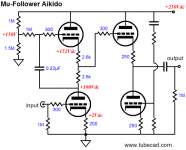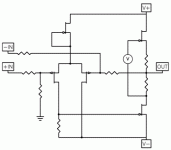In other words: The lower resistor, serial connected to the load, develops a voltage across itsef which, through a biasing voltage source, modulates the current source Jfet
it's always like that - when you have SRPP
question is - why that resistor is divided in two

anyway - I imagine that two ( identical ) resistors are used to ensure equal Ri of upper and lower halve , looking from load side ..... or adequate output impedance , if you wish ;
imagine that you have just source resistor in upper halve , with value of these two resistors ; that's good enough for Shunt Regulating upper side of Push Pull .
but - these two halves will not have same or "enough" same internal resistance , and result must be in some asymmetric behavior ;
that's usually not of importance in tube stages , where bias voltage is negligible comparing to output swing ( not taking output impedance in account this time ...... or output signal tapping point) but - here - 1V2 certainly isn't same as 2V4 - comparing to overall voltage of 2x20V++
Last edited:
...imagine that you have just source resistor in upper halve , with value of these two resistors ; that's good enough for Shunt Regulating upper side of Push Pull ...
Aren't we in a single ended topology rather than a push pull one?
Te upper resistor is not in the output signal path but is part of the current source.
question is - why that resistor is divided in two
The SRPP circuit diagrams as seen at John Broskie's Guide to Tube Circuit Analysis & Design have one resistor, and this maximizes the modulation of the current source tube. If you tap the load below the resistor, then you are going for a constant current source.
Tapping off the "middle" of the resistors, that is to say between two resistors, sets a middle performance, which is referred to there as the "mu follower".
The SRPP circuit diagrams as seen at John Broskie's Guide to Tube Circuit Analysis & Design have one resistor, and this maximizes the modulation of the current source tube. If you tap the load below the resistor, then you are going for a constant current source.
Tapping off the "middle" of the resistors, that is to say between two resistors, sets a middle performance, which is referred to there as the "mu follower".

So with a novices eyes, this 'Aikido mu follower'appears to be a close representation of the J2 simplified circuit.
The two tubes on the left are replaced by 2x 2sk170 on top, and 2sj109 on bottom on the negative rail. Followed by the SemiSouth JFETs.
Of course, I think that's what Nelson said....
Attachments
So with a novices eyes, this 'Aikido mu follower'appears to be a close representation of the J2 simplified circuit.
The two tubes on the left are replaced by 2x 2sk170 on top, and 2sj109 on bottom on the negative rail. Followed by the SemiSouth JFETs.
Of course, I think that's what Nelson said....
The Aikido has mu-follower input, and a cathode follower output.
The only thing similar is that both has some sort of Mu follower in it.
Listening to the J2
So you want to end the suspense. I have heard the J2, both at RMAF and in my home.
It is stunning. Just a touch of sweetness, extended, fast, ultra-low distortion, transparent to the source as you could want. My E-Mu 1616M running 24/192 dubs off the master tapes sounded exquisite. Until the J2. Now I hear the op-amp.
Not that it is ruthless, and imperfect stuff is annoying as hell (true of amps which run too much global feedback, squeezing the dynamics and life out of the music), it does allow a clear view of the recording. But that touch of sweetness, and the clear dynamics - they make things sound, well, like music! Yes, I heard the op-amp, and thought it could be better. But that never made me want to turn the music off.
Listened all day at RMAF, then held after-hours sessions for friends and guest. No fatigue, but tons of fun.
Not good. Not great. Phenomenal. The best First Watt yet.
Guess what? This does not end the suspense. You have to hear one to believe it. Only that will end the suspense.
So you want to end the suspense. I have heard the J2, both at RMAF and in my home.
It is stunning. Just a touch of sweetness, extended, fast, ultra-low distortion, transparent to the source as you could want. My E-Mu 1616M running 24/192 dubs off the master tapes sounded exquisite. Until the J2. Now I hear the op-amp.
Not that it is ruthless, and imperfect stuff is annoying as hell (true of amps which run too much global feedback, squeezing the dynamics and life out of the music), it does allow a clear view of the recording. But that touch of sweetness, and the clear dynamics - they make things sound, well, like music! Yes, I heard the op-amp, and thought it could be better. But that never made me want to turn the music off.
Listened all day at RMAF, then held after-hours sessions for friends and guest. No fatigue, but tons of fun.
Not good. Not great. Phenomenal. The best First Watt yet.
Guess what? This does not end the suspense. You have to hear one to believe it. Only that will end the suspense.
Yes Jon All of what you say is true. And yes Jon, I Had to order one from Mark. I can't wait to pop the lid.
What hath Nelson wrought?
I have built a number of his designs over the years and each has been a revelation at the time. This will be a first for me to actually PAY real dollars for a design. But you know what?...It feels good to help support people like Nelson,Colin, partners and others.
Thank you Nelson Pass and Family etc.
BTW seems one of The Feastrex guys, Chris Whitmer, was killed yesterday on his bike.
More info on the Feastrex fourm. The guy have a wife and 7 girls. So sad.
What hath Nelson wrought?
I have built a number of his designs over the years and each has been a revelation at the time. This will be a first for me to actually PAY real dollars for a design. But you know what?...It feels good to help support people like Nelson,Colin, partners and others.
Thank you Nelson Pass and Family etc.
BTW seems one of The Feastrex guys, Chris Whitmer, was killed yesterday on his bike.
More info on the Feastrex fourm. The guy have a wife and 7 girls. So sad.
.........
BTW seems one of The Feastrex guys, Chris Whitmer, was killed yesterday on his bike.
More info on the Feastrex fourm. The guy have a wife and 7 girls. So sad.
oh man ........
sad , so sad .
RIP.
BTW where can I buy a J2 close to Atlanta and how much do they cost? I can not afford an X.5 but the J2 is doable. I think we are getting closer to the Grail.
Thanks Nelson for these toys.
What would you recommend for a speaker setup to achieve maximum benefit from this product?
Tad
Thanks Nelson for these toys.
What would you recommend for a speaker setup to achieve maximum benefit from this product?
Tad
Speakers for J2
Since Nelson answered the first part of your question (dealers), I will answer the second (speakers).
The amp is rated at 25 wpc. So you need something of moderate to high efficiency, depending on how loud you play music. If you like really loud music, think in terms of 95 dB. That will get real loud, and a have a bit of headroom.
If you are more reasonable in your listening, 85-90 dB speakers will work just fine, with some headroom. You always want some headroom, amps sound better when not stressed as a rule, although I can't say I have stressed the J2's too much with my 99 dB speakers.
Of course the ideal speaker is a Lowther Field Coil, but I will freely admit bias here.
Since Nelson answered the first part of your question (dealers), I will answer the second (speakers).
The amp is rated at 25 wpc. So you need something of moderate to high efficiency, depending on how loud you play music. If you like really loud music, think in terms of 95 dB. That will get real loud, and a have a bit of headroom.
If you are more reasonable in your listening, 85-90 dB speakers will work just fine, with some headroom. You always want some headroom, amps sound better when not stressed as a rule, although I can't say I have stressed the J2's too much with my 99 dB speakers.
Of course the ideal speaker is a Lowther Field Coil, but I will freely admit bias here.
- Home
- Amplifiers
- Pass Labs
- FirstWatt J2


